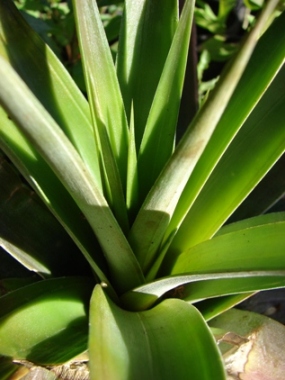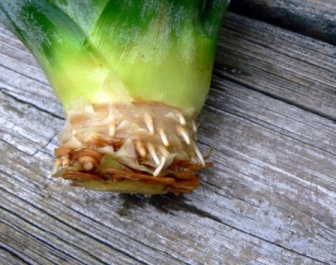Adaptation
There are many restrictions that the pineapple
plant must overcome in order to survive in the wild. They live in
moderately warm areas (16-30 degrees Celsius).Three
important limitations are that it cannot tolerate frost, it is
intolerant of temperatures higher than 40° Celsius (sun also causes
sunburn to the plant), and it has a fragile root system that
requires to be well drained. Well this puts the pineapple plant in
quite a
pickle, considering it can’t be too hot or
too cold to grow. Luckily for us, the pineapple has made some great
adaptations in order to overcome the limitations they have.
Leaves:
The leaves on the pineapple are
specially designed in increase water intake as well as absorb
sunlight. The leaves grow spirally around the stump, with every
Roots:
Pineapple plants have two different kinds of roots. First, they have
the soil roots that start at the base of the stem and grow to form
the underground root system. The second is axillary roots that are
formed on the leaf axils. These axillary roots are a great adaption
for the plant because it allows for direct absorption of water and
nutrients. At the tip of the axillary roots is unlignified white
tissue that allows for absorption. CAM photosynthesis:
The pineapple plant undergoes a special
photosynthetic pathway called Crassulacean Acid Metabolism (CAM).
This is a great adaptation because it allows the plant to conserve
moisture. You may be asking how does this work? Well it is a
relatively simple process.
At night, the stoma open and fixes carbon dioxide to be
stored as malic acid, which is used during the day when the stomata
are closed and the plant undergoes photosynthesis. (9) Two other CAM
plants are
Peyote and
Aloe Vera. Well those are some pretty cool adaptations
that the pineapple plant makes. Now lets see what they use for
nutrition
here
or return to the homepage
here.
 thirteenth leaf being five turns of the stem and directly above the
first leaf. The leaves
of bromeliads have a colorless and translucent water storage tissue
that is used to store water for later use, such as periods of
drought or inadequate moisture. Stomata are also used to increase
water intake. Stomata are pores in the leaf that open and close that
allow for gas and water exchange. Carbon dioxide enters the plant
through the stomata and moisture leaves through them. Pineapple
plants also have trichomes on the underside of the surface of the
leaves. Trichomes are tiny, hair-like structures that surround the
stomata to prevent any further water loss.
thirteenth leaf being five turns of the stem and directly above the
first leaf. The leaves
of bromeliads have a colorless and translucent water storage tissue
that is used to store water for later use, such as periods of
drought or inadequate moisture. Stomata are also used to increase
water intake. Stomata are pores in the leaf that open and close that
allow for gas and water exchange. Carbon dioxide enters the plant
through the stomata and moisture leaves through them. Pineapple
plants also have trichomes on the underside of the surface of the
leaves. Trichomes are tiny, hair-like structures that surround the
stomata to prevent any further water loss.
